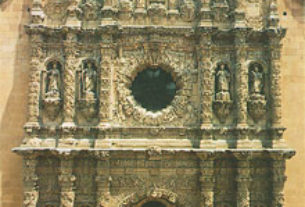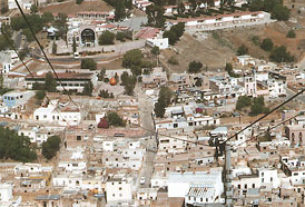I had heard about San Juan de Los Lagos, and its exvotos, for many years. A stay in Guadalajara gave me the opportunity to visit; I was not disappointed. When I first walked into the Basilica, I knew that I was in a special place. ; There were many pilgrims standing in front of the altar, looking up adoringly at the statue of the Virgin. The pews were full of people, even though there was no service taking place. I have been to hundreds of Mexican churches, but I had never seen this level of devotion.
San Juan de los Lagos is the second most popular religious pilgrimage site in Mexico, with seven million visitors a year. The pilgrims are there to pay their respects to the Virgin; the statue of the Virgin is regarded as miraculous. During a religious feast day, you can hardly move in and around the church. The important feast days are February 2nd, most of May, the 15th of August, and the 8th of December, the feast days associated with Mary. The Virgin is generally referred to as the Virgin of San Juan de los Lagos, but is sometimes referred to by her native name, Cihuapilli, which means “Great Lady.”
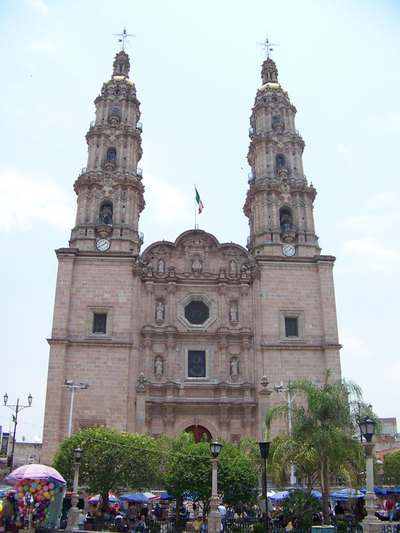
The Pilgrims
The pilgrims come from all parts of Mexico. Organized groups will walk hundreds of miles to San Juan de los Lagos; large bicycle pilgrimages culminate in San Juan de los Lagos. But most modern pilgrims arrive by car or bus. Many pilgrims go the entire length of the church on their knees. One pilgrim family that I spoke with said that they came to fulfill a manda, a promise; they were among those who went down the aisle on their knees.
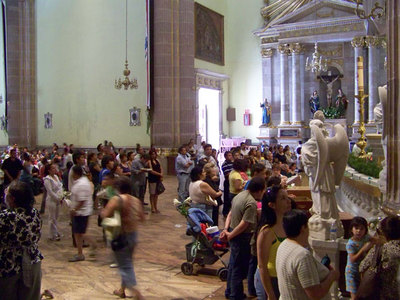
It is impressive to see a crowd of people at the foot of the altar, looking up adoringly at the statue of the Virgin. The pilgrims will stand, or sit in a pew, for a long time. There is a steady flow of pilgrims in and out. Some of the pilgrims take home a bottle of holy water or a memento from the church, conveniently available on the way out.
The Exvotos – Thank you, God
Exvotos are a form of votive offering, given in thanks for a blessing from God. In the Mexican tradition, they are a mix of folk art, story, and thanks. Sometimes I refer to them as “personal thank you notes to God.” In many cases, the exvoto is part of a promise that they made to the Virgin; if they received what they were praying for, they had promised that they would travel to San Juan de los Lagos and leave an exvoto.
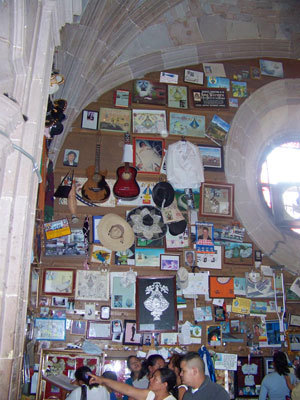
Exvotos are often extremely specific, giving the details, names, and dates for which the person wishes to give thanks. In some cases, there will be a long story written out. They can be as simple as a hand written note, or as elaborate as a piece of folk art framed behind glass. The biggest exvoto that I have ever seen is an entire chapel in Tequila, Jalisco, built in 1948 to fulfill a promise; this is an exceptional case, and I am going to focus on the types of exvotos more commonly seen.
Exvotos are sometimes referred to as retablos. You will occasionally see them in museums, or shamefully, for sale in antique stores. Some churches that once had walls full of exvotos have removed almost all of them. In some cases they have been removed to protect them, but then no one can see them. But if you want to see exvotos, it is not necessary to travel hundreds of miles. If you ask, someone will know of a church in the area that has a tradition of exvotos; only a small percentage of Mexican churches contain exvotos.
In San Juan de Los Lagos, the exvotos are in a room to the side of the altar, where they cover the walls from floor to ceiling. They have two men assigned to take care of the room and the exvotos. They told me that they move the older exvotos up higher, and ultimately to storage. In many cases, there are exvotos hung on top of other exvotos, because there are so many.
The traditional exvoto was painted on tin, and included a drawing, often showing someone kneeling in front of Christ or a saint. It might have been painted by someone hired for the job, especially if the giver was illiterate. The modern exvoto is generally on paper, but the form can vary greatly. In some cases, it could be a simple hand written note on a small sheet of paper, perhaps written on the spur of the moment. In other cases, the note may come from a computer or even a photocopier. It is common to include a photo of the person in the story. The more elaborate exvotos are often framed. Others might leave an object behind, such as a crutch or a shirt. In other words, the modern exvoto comes in many forms. A person may give thanks for themselves, or for a family member. Many people are only interested in the traditional exvotos, but I find the modern exvotos just as interesting.
Exvotos are both very public and extremely personal. A personal story is posted in a public place, inviting anyone to read. The whole point of the exvoto is public thanksgiving; otherwise one could just pray and give thanks in private. In many other countries, the exvotos are virtually anonymous, giving thanks for an unspecified “favor granted,” and signed only with initials. Most Mexican exvotos make it very clear why they are giving thanks, generally containing names, cities, dates, and many other specifics. Some of the stories make you want to cry. A few of the people giving thanks are still suffering, but giving thanks because they or their loved ones are still alive.
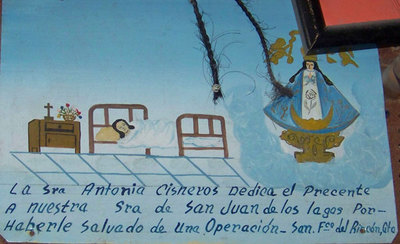
The subject matter of the modern exvoto is largely the same as the older exvotos. That is, the most common reason for giving thanks is healing from an illness or surgery; the second most common reason is escaping from an accident without being killed. Beyond those subjects, you will see thanks for employment, graduating from school, material goods, finding a lost horse, you name it. Most of the photos that I took were pictures of the unique exvotos, rather than the more common exvotos, of recovering from illness or surgery.
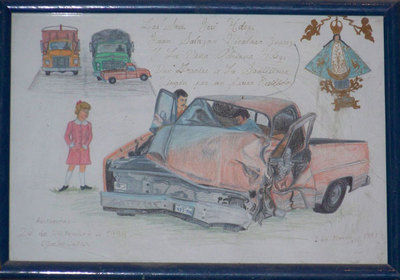
The exvotos that are photocopies are not folk art, but are still an honest expression of faith and thanksgiving. In many cases, they involve a photocopy of a diploma or transcript, or even a report card, showing successful completion of a course of study. Occasionally one has to read the text to figure out why the photocopy is an exvoto; for example, I have seen one exvoto which was the minutes of a meeting, during which the commission granted retirement to an employee. So the photocopy exvoto is both personal and impersonal; it is the product of a machine, and requires little effort on the part of the giver, yet it generally contains the dates, name, address, and exactly why this person is giving thanks.
Some exvotos are not great stories of triumph; they talk of prison, alcoholism, or leaving an abusive family situation. But these people are giving thanks in a very public way, even if it means airing the family’s dirty laundry in public.
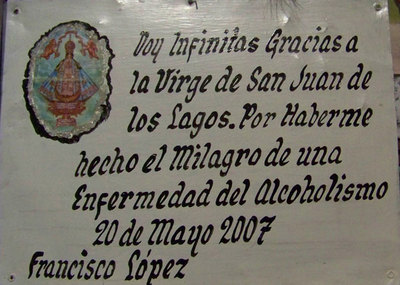
In San Juan de Los Lagos, I saw many portraits of soldiers in a U.S. military uniform, with the family giving thanks for their soldier’s return from a war zone.
Some of the exvotos are awards. In one case, a musician took the gold record that he received and put it in the church. There are many sports trophies on the wall at San Juan de Los Lagos. People will take a prestigious award, which they could display in their home or office, and offer it to the Virgin. One professional soccer player left his jersey and a note giving thanks for his career.
History
The statue of the Virgin dates from the early 1500s, and is believed to have been brought to the area by the early missionaries. The statue is made of sugar cane paste, light and easily molded. Statues of this kind were made in Michoacan, where this statue is believed to have been made. It is very small, 38 cm (15 inches) tall.
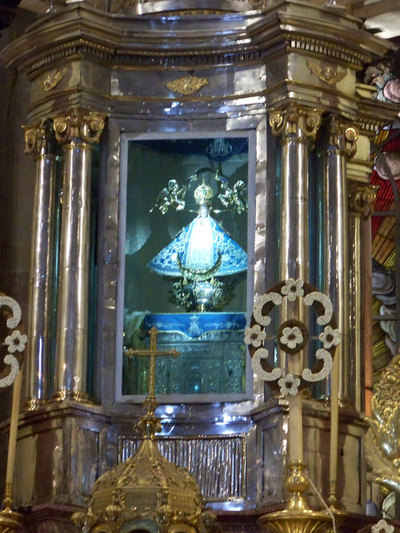
The first important miracle attributed to the Virgin dates to 1623. A family of acrobats came to town. Part of their act was to fly over a field of spear points, to impress the crowd. The seven year old daughter slipped during their act, fell upon the spears, and immediately died. The local women brought the statue to the body, and prayed over it for four hours, until the child revived. This was not the first miracle attributed to the Virgin, and no one could count the miracles reported since then. The news of the miracle traveled far and wide, and the King of Spain granted permission for San Juan de Los Lagos to be officially established as a city.
The original hermitage was primitive; the first real church dates from 1643. The second church was started in 1732, and finished in 1779, although the towers were not finished until later. There were a steady flow of gifts, which allowed the church to become more and more impressive.
The church fell on hard times during the war of Mexican independence, which reduced the flow of pilgrims and gifts; some of the caretakers were laid off. But with the end of the war, the pilgrims and gifts returned.
In 1904 the Pope granted permission for the crowning of the Virgin. The church was elevated to a minor Basilica in 1947, and to a Cathedral in 1972. Pope John Paul was himself a pilgrim to San Juan de los Lagos in 1990. The statue of the virgin was restored by sculptors in 2005.
The town of San Juan de Los Lagos
The town of San Juan de Los Lagos is in Jalisco state, about two hours northeast of Guadalajara. The economy of the town of 40,000 residents is based on serving the needs of the seven million pilgrims per year. The town has frequent bus service, and is accessible by expressway. Most English language guidebooks do not even mention San Juan de los Lagos.
A manifestation of faith
In San Juan de los Lagos, the pilgrims and the exvotos are continuing and dramatic manifestations of the faith of the Mexican people. I find the pilgrims and the exvotos endlessly fascinating and impressive. A visit to San Juan de los Lagos will allow you to see perhaps the best collection of exvotos in Mexico. What newer exvotos may lack in folk art, they often make up for by the vivid and personal stories they tell. Especially if you can read Spanish, it is well worth your time to look at exvotos, wherever you can find them.
Bibliography:
- Compendio de la Historia de Nuestra Señora de San Juan de los Lagos, by Sr. Cango Aguayo
- Further reading: Artes de Mexico magazine issue 53 is on exvotos. Artes de Mexico also published Retablos y Exvotos, a small book. Both were published in Spanish.

